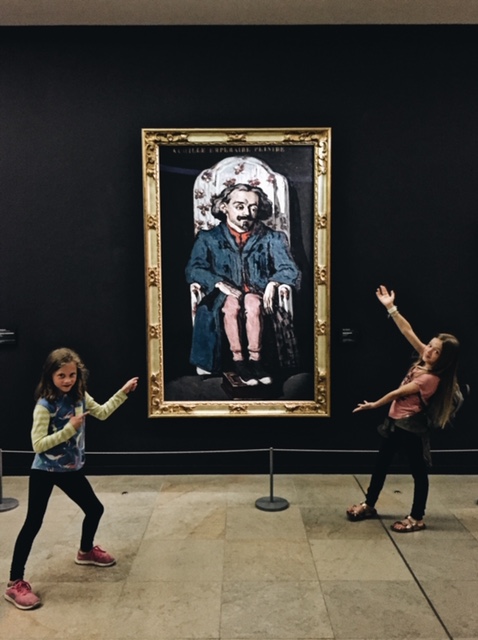
There’s this point in Odysseus’ quest when he lands on a shore the farthest point from home: the Underworld. Odysseus takes his sword and very, very carefully digs a pit two feet square in the sand. Then into the pit, he “poured a libation all around to the dead, first of milk and honey, then of sweet wine, thirdly of water, sprinkled with white barley meal.”
The offering draws a crowd of dead souls to come eat and drink. That’s disgusting. But effective. Because in breaking bread with the dead, Odysseus learns things he didn’t know in the land of the living.
When I visited the Musée d’Orsay in Paris last summer, I would not have paralleled my visit to Odysseus’s unpredictable adventures, not the least jarring of which was that dinner party in the Underworld. I thought I was just standing in a very long line, buying a ticket, and strolling through one of my favorite museums in the world. Today, a revolution of the earth around the sun later, I categorize my visit as a quest of unpredictable adventures, guided by a polar bear.
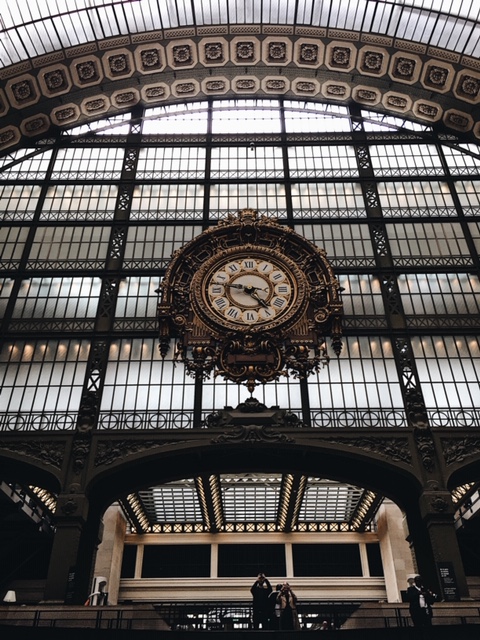
Our guide joined us via a postcard in the gift shop, which visitors encounter at the entrance of the Musée d’Orsay. Traveling with a 10 and 7-year-old, there was some urgency to create a museum scavenger hunt using ten postcards purchased before entering. Among the rows of Picassos, Renoirs, Monets, and Rodins, my girls zeroed in on the lesser-known François Pompon sculpture of a marble behemoth of a bear.
We set out to find L’Ours Blanc, immediately nicknamed “Pompon,” first. It would be our last discovery. To arrive at Pompon’s pedestal, our Odyssey took unexpected twists through the galleries.
W.H. Auden suggests, “Art is our chief means of breaking bread with the dead.”
In the Musée d’Orsay, we encountered souls of sculptors, painters, cabinet makers, and artists long dead. We broke and sprinkled bread to lure them in, peppering them with questions to guide us through the land of the living. Here’s what I learned.
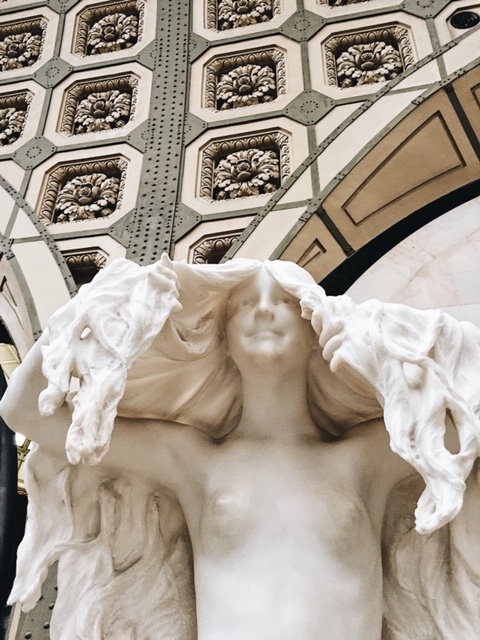
From “Aurora,” by Denis Puech, 1900
There’s a certain look, speed, and stance one should assume to navigate a museum. A sweep of the feet, a cocked hip, perhaps a finger laid just so along the jaw. My family did not buy into this mode. We flung arms skyward in “Ta-daaaa” poses, we aggravated security guards by nosing in on brush strokes, and we sunk to our knees peering upward at grotesque sculptures.
We flagrantly imitated art. And it was glorious.
I gave my oldest American daughter a French name for her future good. One day, she would order croissants in a Parisian pâtisserie and not be alarmed by a garbled name coming out of a French mouth.
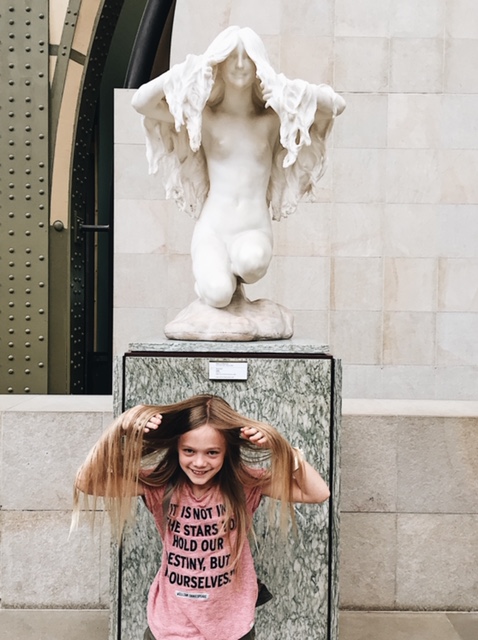
Denis Puech draped Isabelle in France more winsomely than her name ever could. There’s Peuch’s Aurora, peeking modestly but expectantly from a horizon of hair. And my Isabelle gamely shed all museum discretion and mimicked the hair curtain perfectly.
She was ten years old, closing out the first decade of life. She was at her dawn, an Aurora peeking over a horizon to see what would be hers to live in the decades ahead: sailing into her noonday prowess, reclining into sunset, and dipping below the surface to extinguish. I froze Isabelle in front of Aurora for pictures, so very glad she began her ascent with silliness and not frozen museum restraint.

From “Mil Huit Cent Soixante et Onze” (1871), by Paul Cabet, 1871
What was going on with the year 1871? Because in marbleized personification, 1871 sure looks a heck of a lot like 2020 feels. Appreciating the sculpture in 2019, I had no premonition of what 2020 would introduce, so in that more innocent of years, I made Paul Cabet’s sculpture unadvisedly personal: I saw a mama having herself a moment after ushering two jet-lagged, disenchanted, hangry children around Paris.
This mother of 1871 is beautiful in her deflation. She regularly gathers crowds to her pedestal to admire her smooth perfection. But I saw broken fingers. Stumps on her curled left hand.
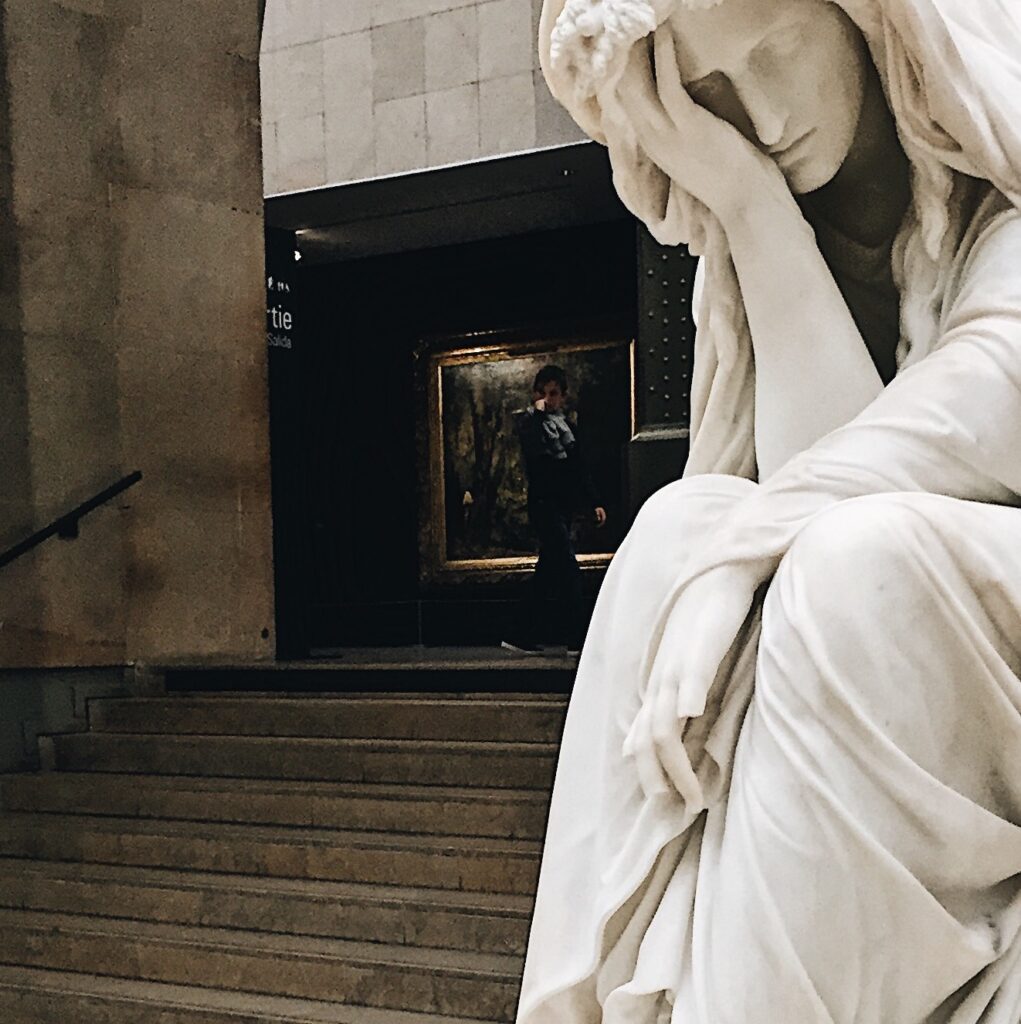
The detail became an inside joke between my husband and I for the rest of our time in France. Overcome with a case of the 1871s, we would shoot each other a look and hold up a hand with crooked fingers. Weary of the voyage, the children, the life, the year, and just taking a moment to immobilize that hard truth, we took the risk of passing the rest of the centuries ahead frozen, broken, and admired.
Paul Cabet broke bread with me, teaching me the power of brokenness so beautiful it draws a crowd who willingly pays a museum fee to stand witness.
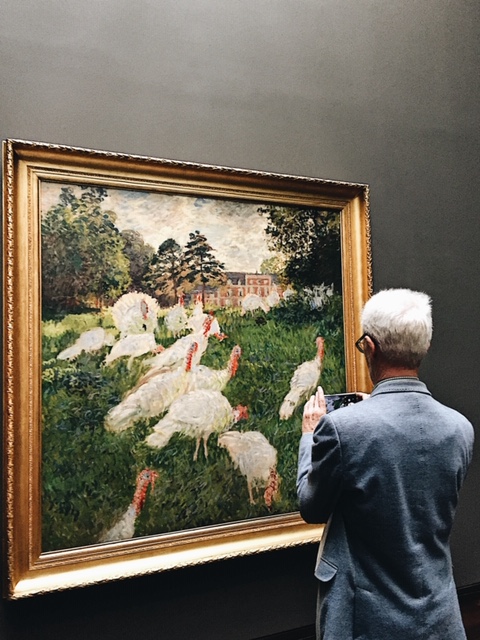
From “Les Dindons (The Turkeys),” by Claude Monet, 1876
One must take Monet seriously. One must present his water lily paintings with rapture that clangs so loudly in my children’s brains they can never un-hear the echoes. Instead, we encountered Monet’s canvas of turkeys. And I could not have been more delighted with the juxtaposition.
Claude sidled up to commune, and he gave me a nudge. He twitched his beret like a rogue. “Bien sûr,” he intimated. “The water lilies are great and all. But have you seen what I can do with a turkey, given a paintbrush and half a moment’s chance?” He actually winked. Never underestimate the mighty Monet and his dindons.
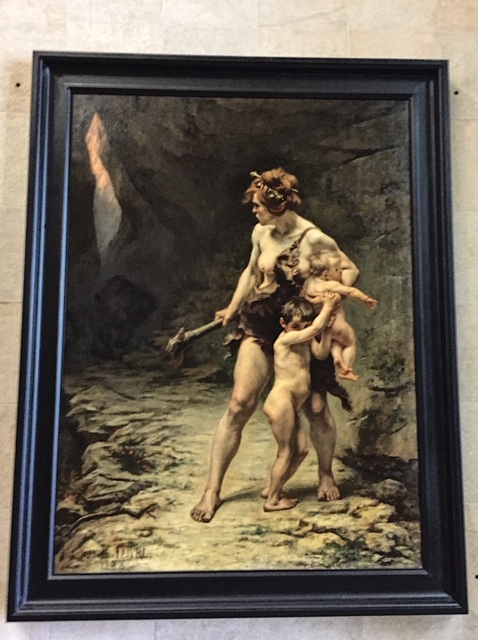
From“Two Mothers,” by Léon Maxime Faivre, 1888
The fear on the cave mama’s face arrested me. What could possibly cause such ferocity on a woman’s face? I again inadvisedly made the art personal. My greatest mothering fears: My children will have unpronounceable names, my children will have epic meltdowns in line for museum tickets, my children will tumble from an Eiffel Tower platform, my children will trip under the wheels of a Métro car, my children will not want to return to Paris.
I run through my catalog of fear as I step closer to see what rivets the cave mama’s attention. And then I spy the threat emerging from those dark recesses of the cave: a bear.
The cave mama is clearly the natural product of the Crossfit gym of her era. She hunkers in the same protective instinct to gather and, if necessary, launch her children out of harm’s way, just as I imagine myself doing if my children stumbled in the path of a speeding métro train in 2019. One bared breast, the eternal symbol of nurturing motherhood, is clearly this mama’s last concern, despite the fact her nudity is now displayed for centuries of peeping eyes. She keeps her eye on fear and her hand on a club.
When Léon Maxime Faivre approached to break bread, I whispered, “I want to be this cave mama.” And then Maxime, with a knowing little smile, simply pointed a finger at the title of his painting, directing me to think again.
“Two Mothers” I read. And that’s when my heart split in half.
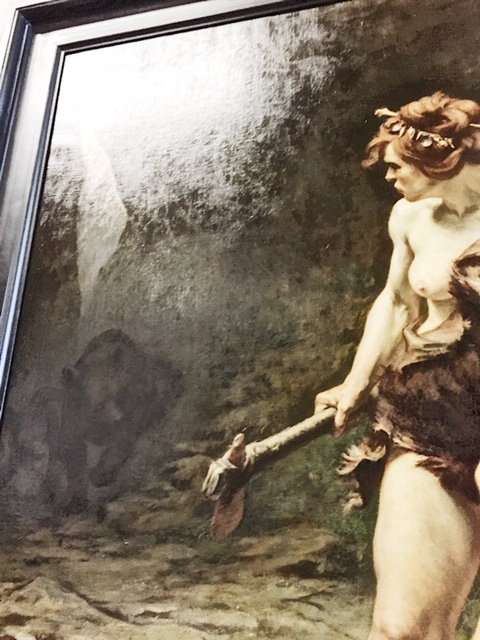
Because this painting isn’t about just the human cave mama, but also about the ursine cave mama. That bear threat in the background? She must be a mother too. Standing vigil between her babies and the greatest fear to enter her world: a two-legged, muscular she-beast wielding a club.
My heart divided in stalemate empathy between each mama. I froze before this painting for long minutes. A lifetime. After a thousand eternities passed, my children pulled on my hand and led me safely away from the threat I couldn’t take my eyes off of.
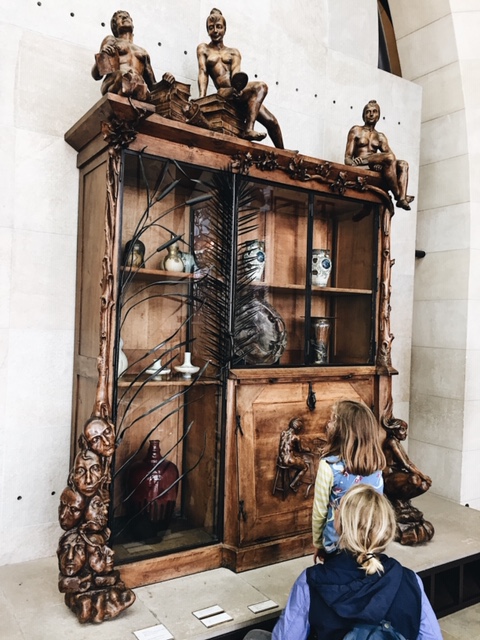
From Bookcase, François-Rupert Carabin, 1890
“I remember looking at that because it was kinda cool and fancy looking and it belonged to some sort of queen, so yeah.”
I’ve just asked my now eight-year-old if she remembers a certain cabinet we discovered in a deserted gallery of the Musée D’Orsay. My daughter’s adjectives lack creative flair, but I’m glad a hulking piece of furniture stands out in her memory as much as the museum greats, all those Monets, Renoirs, Degas, Rodins, and Picassos.
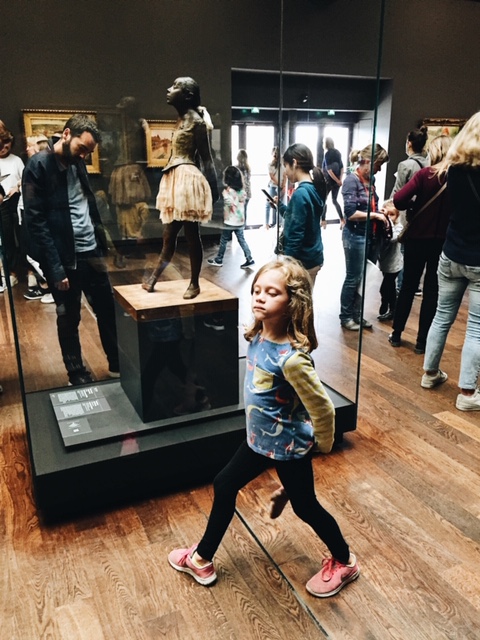
This same child had posed in mimicry of Degas’ dancing girl, asserting a forcefield to keep the crowds at bay for the nine seconds it took me to compose and shoot the photo.
We had no pressure to pose, click, and move on in the bookshelf’s gallery. Our voices bounced back from parquet floors. The windows across from the cabinet framed the Seine and the open arms of the Louvre.
François-Rupert Carabin approached for his turn at bread-breaking and stuffed a hunk of baguette in his mouth. I don’t think the poor soul gets many visitors at his communion table. He seemed a bit starved for bread and company. He chewed and gave a little nod of his head, “See the asymmetry?”
We saw it.
“Cool, huh?” From an artist, I expected slightly better adjective selection than an eight-year-old, but what do I know? Nothing about his bookcase met expectations. “See what I did there? Started with a cube. Then I made it go all wonky.” I believe that might be his synonym for “asymmetrical.”

“Certainment, I piled up on some crazy dudes at the bottom left corner. Passions that are the enemies of intelligence. Critters that can only be vanquished by books: Vanity, Greed, Intemperance, Anger, Folly, Hypocrisy. Just look at them all squished down there. Even got one with his tongue sticking out.” He harrumphed to clear some bread from his gullet.
My girls and I noted some very different figures perched at the top of the cabinet. Carabin continued more politely with an empty mouth: “Them? That’s Truth in the middle and two ladies representing Reading on either side.”
Carabin didn’t rush away after his meal, so I took advantage of our communion a bit longer. “So, this bookshelf?” I wondered. “Isn’t it ironic? It’s supposed to hold the wealth of the world’s books, but the empty cabinet lands in a museum and may just be one of pieces I’ll remember most.”
“Well,” Carabin burped delicately. “When I submitted this bookcase to an artist’s salon back in 1890, they rejected me because they thought then the following year people would be sending in chamber pots. There’s just no reverence these days for the decorative arts.”
Given the lack of tourists populating the furniture gallery around us, I was tempted to think not much has changed since 1890.
Carabin shrugged and whisked crumbs from his fingertips. Shot a final look at his masterpiece. Considered how the past 130 years had treated his work that took 11 months of his life and 3,750 francs. “Kinda cool and fancy looking, n’est-ce pas?”
I know an eight-year-old who couldn’t agree more.
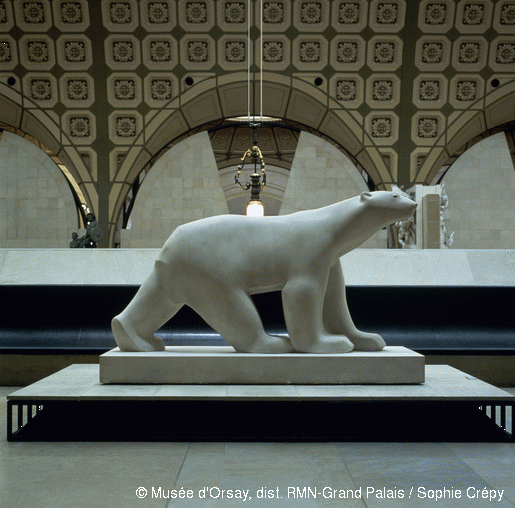
From “Ours Blanc (Polar Bear),” by François Pompon, 1923-1933
Like Odysseus, we did not have enough life to linger long in breaking bread with the dead. We had a quest in the land of the living. Pompon.
Like Odysseus, we searched from the outermost islands of furniture galleries, through whirlpools of tourists threatening to submerge us in Impressionism. We ventured on, seeking the smooth flank of a white bear’s bum.
François Pompon is not one of the artistic greats. He helped the greats. He served as an assistant to Auguste Rodin and from him, gathered wisdom about profile, movement, and power. But Francois Pompon carried forward with less. Rather than follow in Rodin’s example of realistic figures, he turned from humans to animals. In “Ours Blanc,” Pompon did something radical. First, he created a polar bear that looked, down to every last hairy detail, like a real bear. But then he stripped it down. Hacked away the marble flesh to hairlessness.
But I’ll let him explain in his own words.
“I keep a large number of details that will later go” said Pompon. “I first do the animal with almost all its trappings. Then I gradually eliminate them.”
François Pompon joined us shortly after Isabelle became Aurora. Pompon ate on the go, walking alongside, trekking unquestioningly on our ever-widening quest. Our frustration with the elusive bear increased. Pompon didn’t offer any direction. Apparently the dead are not rushed. They have all the time in the (under)world.
On the top floor of the Musée d’Orsay along the very farthest, highest balcony, we finally spied an expanse of trapping-less whiteness. Our way was barred. A sign in French informed us the gallery was closed until further notice. Our quest ended twenty yards short of being able to touch where smooth light flowed over thick, mute marble.
We turned to question Pompon, but he had vanished without a crumb.
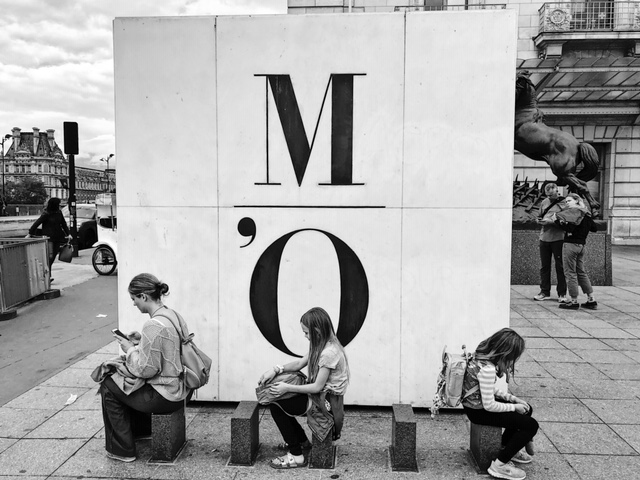
Without saying a word, Pompon had the final word of our artistic communion with the dead. I was convinced in my 2019 visit of Musée d’Orsay that we’d return in 2020, the gallery would be open, and our quest for a polar bear could be completed.
But then, in 2020, a virus flew around the globe, and planes stopped flying around the globe, and I was stuck with a postcard of a white bear sitting on my desk in Pittsburgh, PA.
In the year since our Musée d’Orsay odyssey, many details of life have had to go. Many trappings have been eliminated. Pompon taught me, at the end of the quest, that lack might be just the thing to remember most on the journey.
Missing fingers, missing books, a bear missing its hair. Thanks to art and breaking bread with the dead, I now know in the land of the living that a pared down, stripped away, white bear’s smooth bum is beauty worth seeking tirelessly. Less is more powerful in what is not than in what could have been.


Amazing!!!!
Yup. Amazing. 2020 has certainly given us the wisdom that sometimes, less can be more.